Affiliate links on Android Authority may earn us a commission. Learn more.
Google Pixel review: a technical deep dive
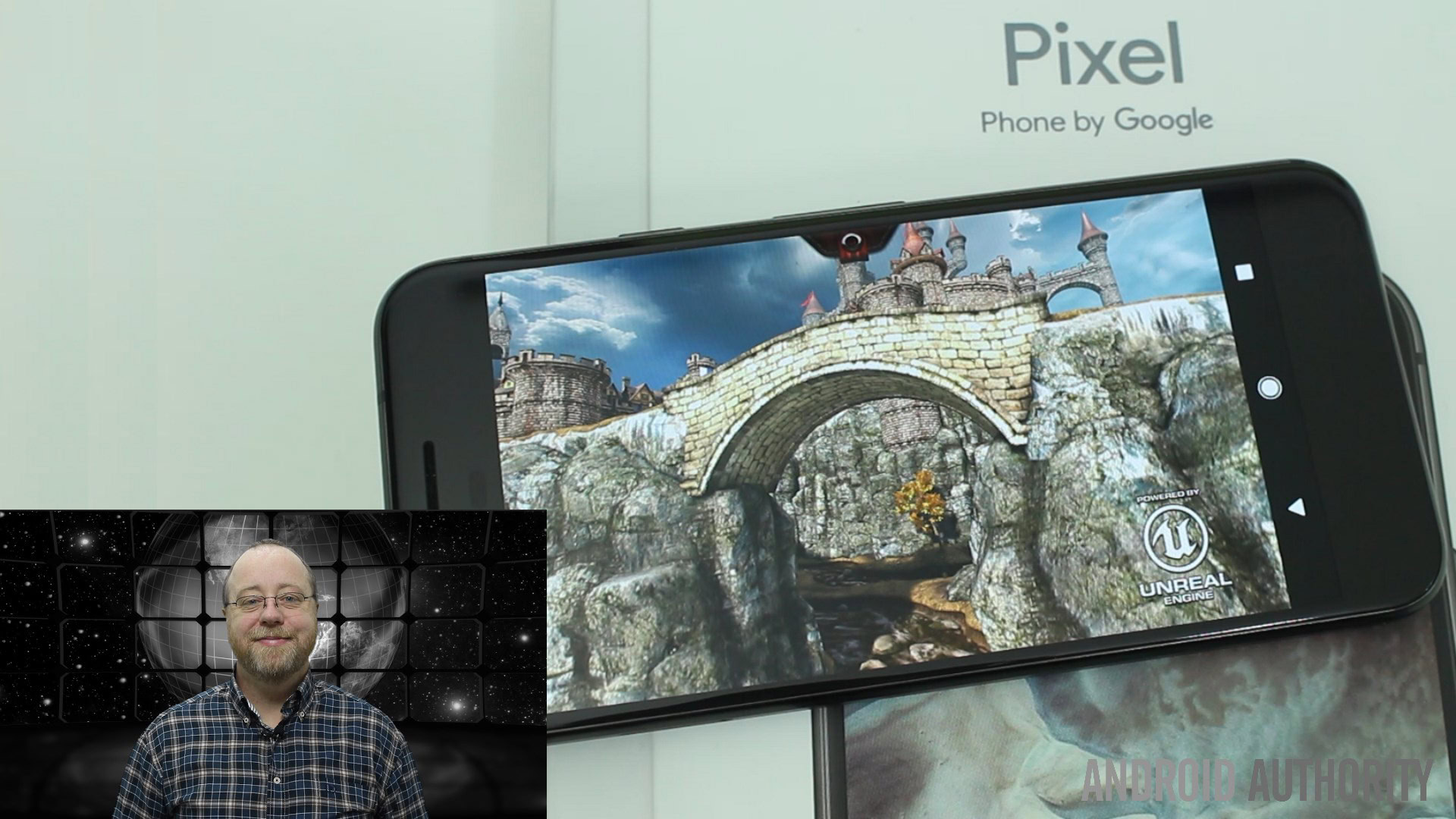
I hope you have enjoyed our reviews of the Google Pixel and Google Pixel XL, however since this is the first time that a phone has had the words “Phone by Google” engraved on it, I think it is worth taking another look at the Google Pixel, not to look at the user experience (which we have already covered) but to take a look at the technology, the geeky stuff, that Google has put into these devices.
To do this I am going to delve a bit deeper into the display, the SoC, the battery, the camera and the software of the Google Pixel. I will be using the smaller Google Pixel for my tests, however a lot of what I cover will also be applicable to the larger Pixel XL. Want to know more? Let’s go.
Specifications
A quick look at the table below will reveal just how much tech has gone into the Pixel and Pixel XL. Hopefully we can expand on this list of specifications a bit and get to understand the significance of some of these items:
| Google Pixel | Google Pixel XL | |
|---|---|---|
Display | Google Pixel 5.0-inch AMOLED 1920 x 1080 441ppi Fingerprint- and smudge-resistant oleophobic coating Gorilla Glass 4 | Google Pixel XL 5.5-inch AMOLED 2560 x 1440 534ppi Fingerprint- and smudge-resistant oleophobic coating Gorilla Glass 4 |
Processor | Google Pixel Qualcomm Snapdragon 821 2.15Ghz + 1.6Ghz, 64Bit Quad-Core | Google Pixel XL Qualcomm Snapdragon 821 2.15Ghz + 1.6Ghz, 64Bit Quad-Core |
GPU | Google Pixel Adreno 530 | Google Pixel XL Adreno 530 |
RAM | Google Pixel 4GB LPDDR4 | Google Pixel XL 4GB LPDDR4 |
Storage | Google Pixel 32/128GB | Google Pixel XL 32/128GB |
MicroSD | Google Pixel No | Google Pixel XL No |
Cameras | Google Pixel 12.3MP rear camera with f/2.0, 1.55μm large pixels, Phase Detection Autofocus (PDAF), Laser Detection Autofocus (LDAF), 4K (30fps) video capture, HD 240fps (8x), Full HD 120fps (4x) slow motion video, broad-spectrum CRI-90 dual-LED flash 8MP front camera with f/2.4 aperture, 1.4 µm pixels, Full HD video capture (30fps) | Google Pixel XL 12.3MP rear camera with f/2.0, 1.55μm large pixels, Phase Detection Autofocus (PDAF), Laser Detection Autofocus (LDAF), 4K (30fps) video capture, HD 240fps (8x), Full HD 120fps (4x) slow motion video, broad-spectrum CRI-90 dual-LED flash 8MP front camera with f/2.4 aperture, 1.4 µm pixels, Full HD video capture (30fps) |
Battery | Google Pixel Non-removable 2,770mAh Fast charging: up to 7 hours of use from only 15 minutes of charging | Google Pixel XL Non-removable 3,450mAh Fast charging: up to 7 hours of use from only 15 minutes of charging |
Media | Google Pixel Single bottom-firing speaker Adaptive audio amplifier 3 microphones (2 front, 1 rear) with noise cancellation | Google Pixel XL Single bottom-firing speaker Adaptive audio amplifier 3 microphones (2 front, 1 rear) with noise cancellation |
Wireless and location | Google Pixel 4G LTE with 3x Carrier aggregation Wi-Fi 802.11 a/b/g/n/ac 2x2 MIMO, dual-band (2.4 GHz, 5.0 GHz) Bluetooth 4.2 NFC GPS and GLONASS Digital compass | Google Pixel XL 4G LTE with 3x Carrier aggregation Wi-Fi 802.11 a/b/g/n/ac 2x2 MIMO, dual-band (2.4 GHz, 5.0 GHz) Bluetooth 4.2 NFC GPS and GLONASS Digital compass |
Network | Google Pixel World-wide network/carrier compatibility with:1 GSM: Quad-band GSM UMTS/WCDMA : B 1/2/4/5/8 CDMA: BC0/BC1/BC10 TDS-CDMA: N/A FDD LTE: B 1/2/3/4/5/7/8/12/13/17/20/25/26/28/29/30 TDD LTE: B 41 LTE 2xCA: B2+B2, B2+B4, B2+B5, B2+B12, B2+B13, B2+B17, B2+B29, B2+B30, B4+B4, B4+B5, B4+B7, B4+B12, B4+B13, B4+B17, B4+B29, B4+B30, B5+B30, B7+B7, B12+B30, B25+B25, B29+B30, B41+B41 LTE 3xCA: B2+B2+B12, B2+B2+B13, B2+B4+B4, B2+B4+B5, B2+B4+B12, B2+B4+B13, B2+B4+B29, B2+B5+B30, B2+B12+B30, B2+B29+B30, B4+B4+B12, B4+B4+B13, B4+B5+B30, B4+ B7+ B12, B4+B12+B30, B4+B29+B30, B41+B41+B41 Pixel is an unlocked phone and works on major carrier networks. | Google Pixel XL World-wide network/carrier compatibility with:1 GSM: Quad-band GSM UMTS/WCDMA : B 1/2/4/5/8 CDMA: BC0/BC1/BC10 TDS-CDMA: N/A FDD LTE: B 1/2/3/4/5/7/8/12/13/17/20/25/26/28/29/30 TDD LTE: B 41 LTE 2xCA: B2+B2, B2+B4, B2+B5, B2+B12, B2+B13, B2+B17, B2+B29, B2+B30, B4+B4, B4+B5, B4+B7, B4+B12, B4+B13, B4+B17, B4+B29, B4+B30, B5+B30, B7+B7, B12+B30, B25+B25, B29+B30, B41+B41 LTE 3xCA: B2+B2+B12, B2+B2+B13, B2+B4+B4, B2+B4+B5, B2+B4+B12, B2+B4+B13, B2+B4+B29, B2+B5+B30, B2+B12+B30, B2+B29+B30, B4+B4+B12, B4+B4+B13, B4+B5+B30, B4+ B7+ B12, B4+B12+B30, B4+B29+B30, B41+B41+B41 Pixel is an unlocked phone and works on major carrier networks. |
Ports | Google Pixel USB Type-C Nano SIM 3.5mm audio jack USB 3.0 data transfer | Google Pixel XL USB Type-C Nano SIM 3.5mm audio jack USB 3.0 data transfer |
Sensors | Google Pixel Pixel Imprint Accelerometer/Gyroscope Magnetometer Barometer Proximity sensor/Ambient Light Sensor Hall sensor Android Sensor Hub | Google Pixel XL Pixel Imprint Accelerometer/Gyroscope Magnetometer Barometer Proximity sensor/Ambient Light Sensor Hall sensor Android Sensor Hub |
Other | Google Pixel RGB LED notification light | Google Pixel XL RGB LED notification light |
Wireless charging | Google Pixel No | Google Pixel XL No |
Water resistance | Google Pixel IP53 | Google Pixel XL IP53 |
Software | Google Pixel Android 7.1 Nougat | Google Pixel XL Android 7.1 Nougat |
Colors | Google Pixel Very Silver, Quite Black, Really Blue (Limited Edition) | Google Pixel XL Very Silver, Quite Black, Really Blue (Limited Edition) |
Dimensions and weight | Google Pixel 143.8 x 69.5 x 8.6mm 143g | Google Pixel XL 154.7 x 75.7 x 8.6mm 168g |
Display
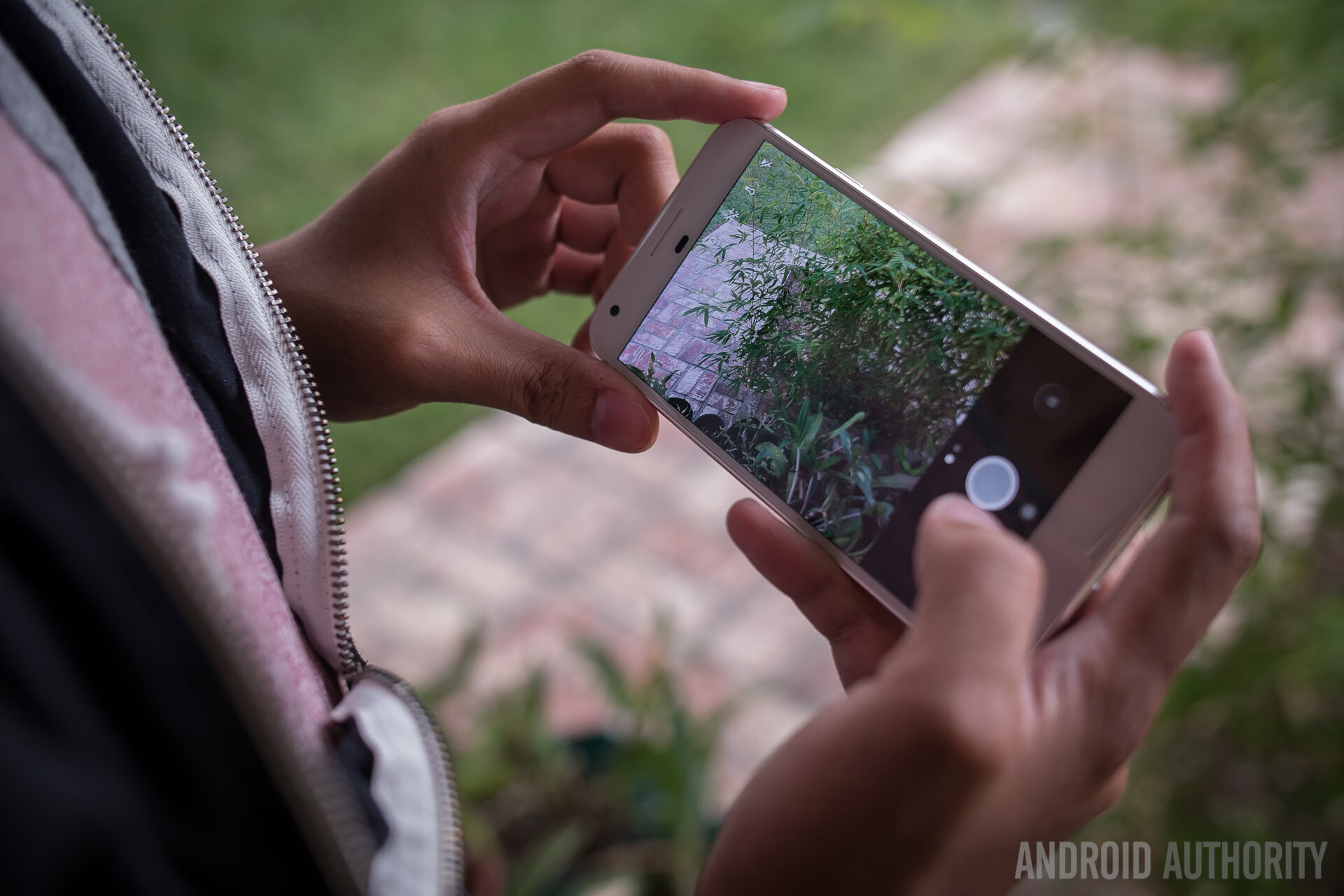
The Pixel comes with a 5 inch Full HD AMOLED display protected by Corning Gorilla Glass 4, while the XL has a 5.5 inch Quad HD AMOLED display also protected by Gorilla Glass. There is no doubt that the displays on both Pixel devices are first class and are a pleasure to use. Looking at some of the tech, we noted in our full review that the display on the XL has a slightly cooler color temperature of 7859 Kelvin, which essentially means the screen has a blue tint. When the display is set to the standard mode (rather than the default adaptive mode), the colors are warmer at 7131k.
This seems also to be true for the Pixel. In terms of color accuracy the display on the Pixel tends to be skewed towards blue when it is displaying green. Notice the top set of vertical points on the graph below, they are left of the pure green target line. The reds, blues and purples however are quite accurate, but not strictly uniform when it comes to the various brightness levels.
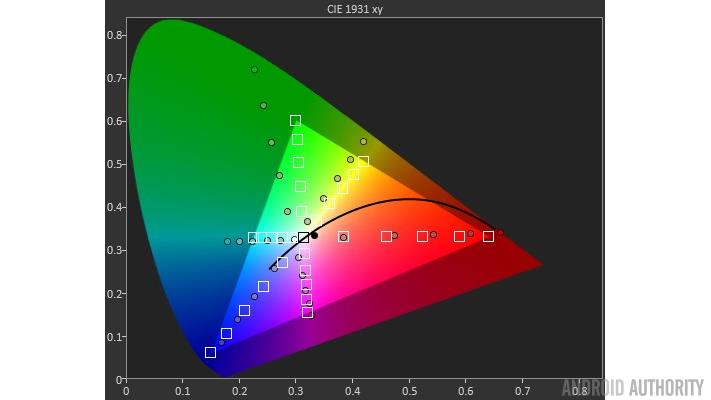
Talking of brightness levels the Pixel’s display has a maximum of 410 nits. That is what you get when the display is on auto brightness and you shine a torch into the light sensor. If you switch to manual mode and crank it up to 100% then the brightness is marginally less at 406 nits. 50% is 208 nits and as you can see from the graph below the brightness profile is quite uniform:
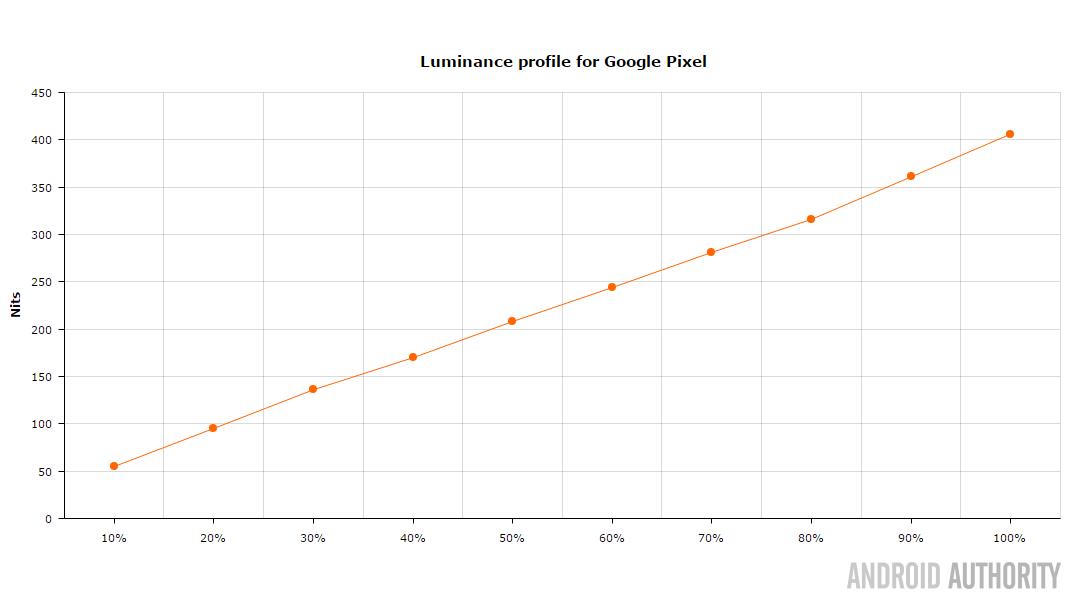
The System-on-a-Chip (SoC) in the Pixel and Pixel XL is the Qualcomm Snapdragon 821. The 821 is the successor to the Snapdragon 820, Qualcomm’s popular SoC which is found in lots of Android devices including some variants of the Samsung Galaxy S7, the LG V20 and the OnePlus 3. The 821 tweaks the design of the 820 to improve power efficiency while increasing performance.
At the heart of the Snapdragon 821 are the quad-core Kryo CPU and the Adreno 530 GPU. Plus there are loads of other bits and pieces including Qualcomm’s Hexagon 680 DSP and the X12 LTE Cat 12/13 modem. You can see from the specification table above that the Pixel supports and impressive number of 2G, 3G and 4G network frequencies.
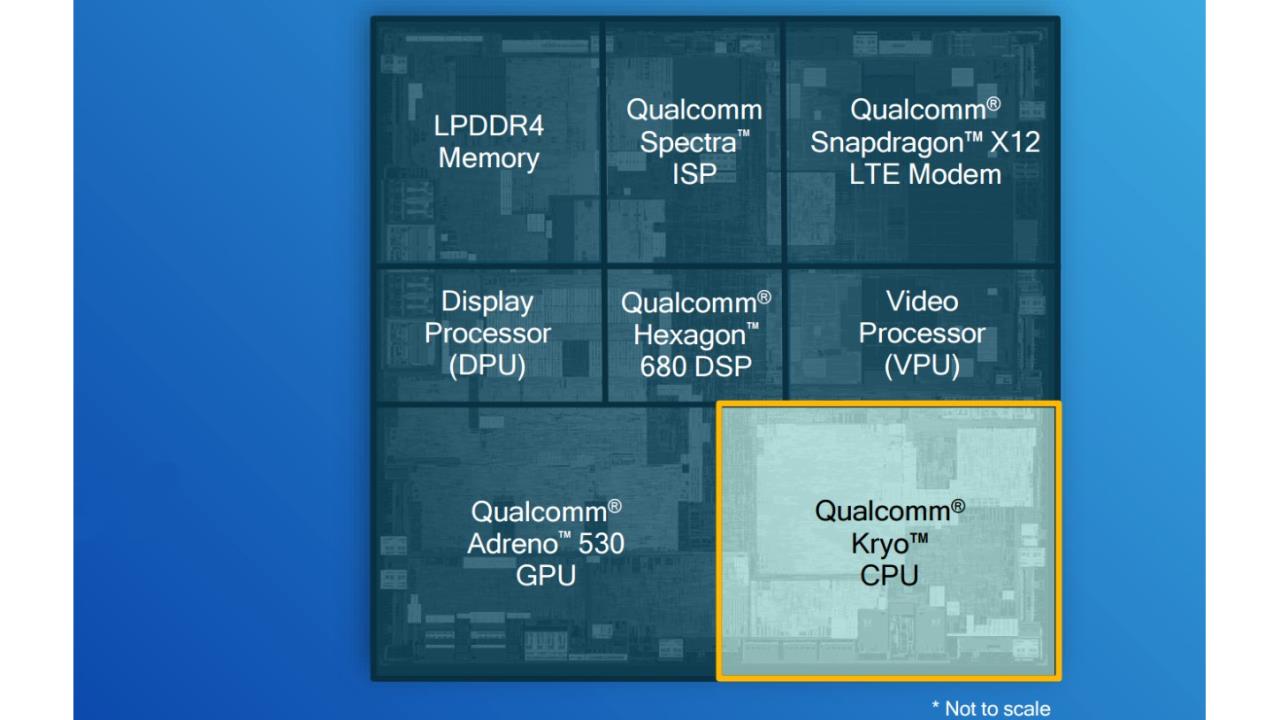
The Snapdragon 820 could be clocked at a maximum of 2.2GHz, however the 821 has been designed to go as high as 2.4GHz. Qualcomm isn’t too forth coming about the architecture of the CPU, however Google has published information which says that the Snapdragon 821 in the Pixel uses 4 Kryo CPU cores, two clocked at 2.15GHz and two at 1.6GHz. The 821’s quad-core setup is what is called Heterogeneous Multi-Processing (HMP).
In general, the quad-core processors found in desktops and laptops have a set of cores which are all equal in terms of their performance and power consumption. In a HMP SoC, not all the cores are equal (hence, heterogeneous). In the Snapdragon 821 the 2.15GHz cores are tuned for performance while the 1.6GHz are tuned for efficiency. When tasks are run on the 1.6GHz cores they use less power, they drain the battery less, however they may run a little slower. When tasks are run on the 2.15GHz cores, they finish sooner but they use more power to do so. Here is where it gets complicated. A task that finishes quicker but uses more peak power to do so, may actually use less energy as it completed the task in a short amount of time. However a task which uses less peak power may use more energy as it took longer to complete.
The ideal situation is where the smaller cores run tasks which don’t use much power but need to run for a long time (like handling the CPU aspects of streaming video). As you can imagine the hardware and software combination needed to make HMP work well is complicated. ARM has done a lot of work in this area with its big.LITTLE system including contributing code to the Linux kernel. As such ARM is quite open about its HMP efforts, however Qualcomm is less so. If you want to know more about big.LITTLE then please read how the Samsung Galaxy S6 uses its octa-core processor.
When it comes to performance the Snapdragon 821 is a beast! Here is a table of some common benchmarks scores for the Pixel:
| Benchmark | Score |
|---|---|
AnTuTu | 141092 |
Geekbench 4 (single core) | 1500 |
Geekbench 4 (multi core) | 4139 |
Sling Shot using ES 3.1 | 2583 |
Quadrant | 31389 |
Basemark OS II | 2331 |
To put those numbers into some context, the Pixel scores higher on AnTuTu than the Samsung Galaxy S7 and the HUAWEI Mate 9. However it scores lower than the Mate 9 for both Geekbench and Basemark OS II.
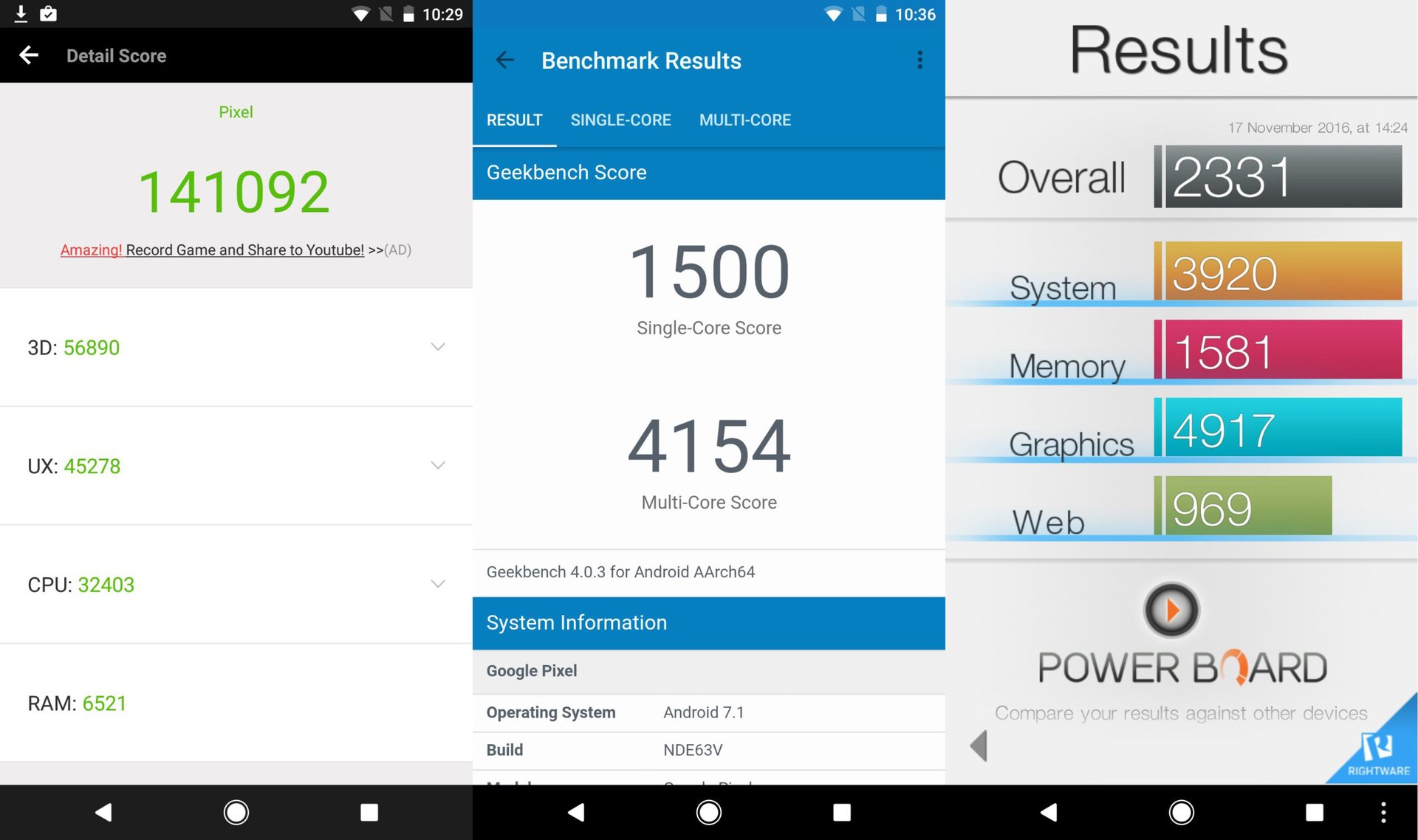
I also tested the Pixel with my own set of custom benchmarks which I have used to test various SoCs in the past including the Kirin 950. The first of my custom benchmarks tests the CPU without using the GPU. It calculates 100 SHA1 hashes on 4K of data and then does some other CPU stuff, I call it “Hashes, bubble sorts, tables and primes. The Pixel gets the best score from any Android phone I have tested!
The second benchmark uses a 2D physics engine to simulate water being poured into a container. Two drops of water are added every frame and the app is designed to run at 60 frames per second. The benchmark measures how many droplets are actually processed and how many are missed. The Pixel scored 10178, which is a good score, but it isn’t the best. The current record holder is the Kirin 960 in the Mate 9, which scores the maximum of 10800.
My third benchmark is written in Unity3D. It is a terrain flyover that yields a frame per second score for a pre-programmed pass over the rendered world. The Pixel scored 37.3 fps, which is again the best score to date.
Battery
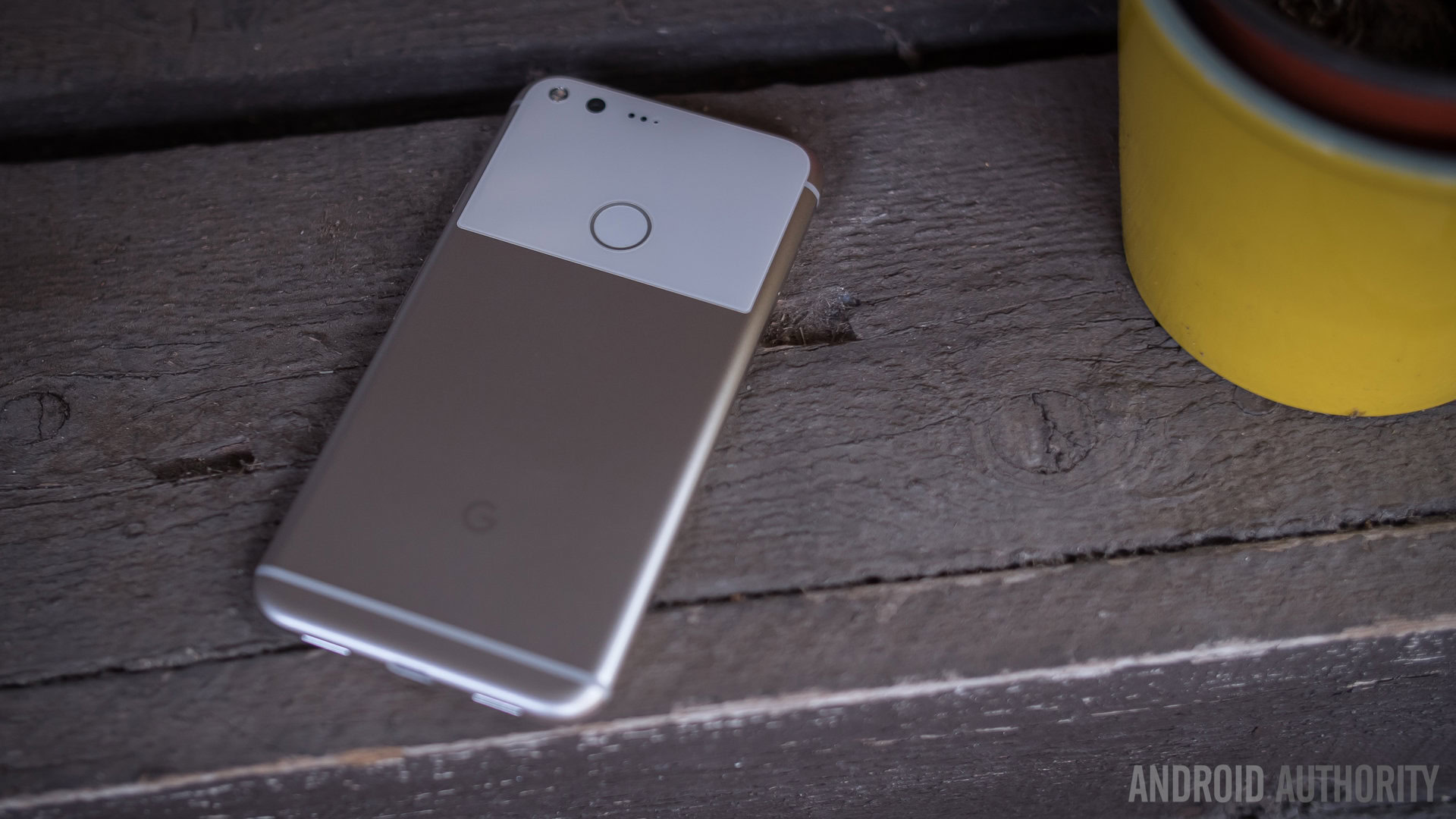
The Pixel comes with a 2,770 mAh battery while the Pixel XL has a 3,450 mAh unit. According to Google that means the Pixel has a 3G talk time of up to 26 hours. Josh, Lanh and Nirave found that during day to day usage you can expect around 5 hours of screen on time. According to my testing with a mixed usage of web surfing, gaming and watching video will give you 5hr 13mins of screen on time, which matches what Josh et al saw.
Google claim that you can get 13 hours of video watching out of the Pixel, but the search giant doesn’t say how bright the display is during the tests. However it does say that “uses that involve an active display will use battery more quickly.” So I guess the brightness level for those tests are low (and fixed). I tested how long the phone can play a looped video from local storage with the display at 47% (i.e. 200 nits). The result was an impressive 10.5 hours!
If you are wondering how much the brightness level affects battery life, well so did I! I re-run my video test, this time with the display at 100%, that’s over 400 nits. The result was an equally impressive 8.5 hours. So upping the brightness can cost you as much as two hours of screen on time for easy tasks like video.
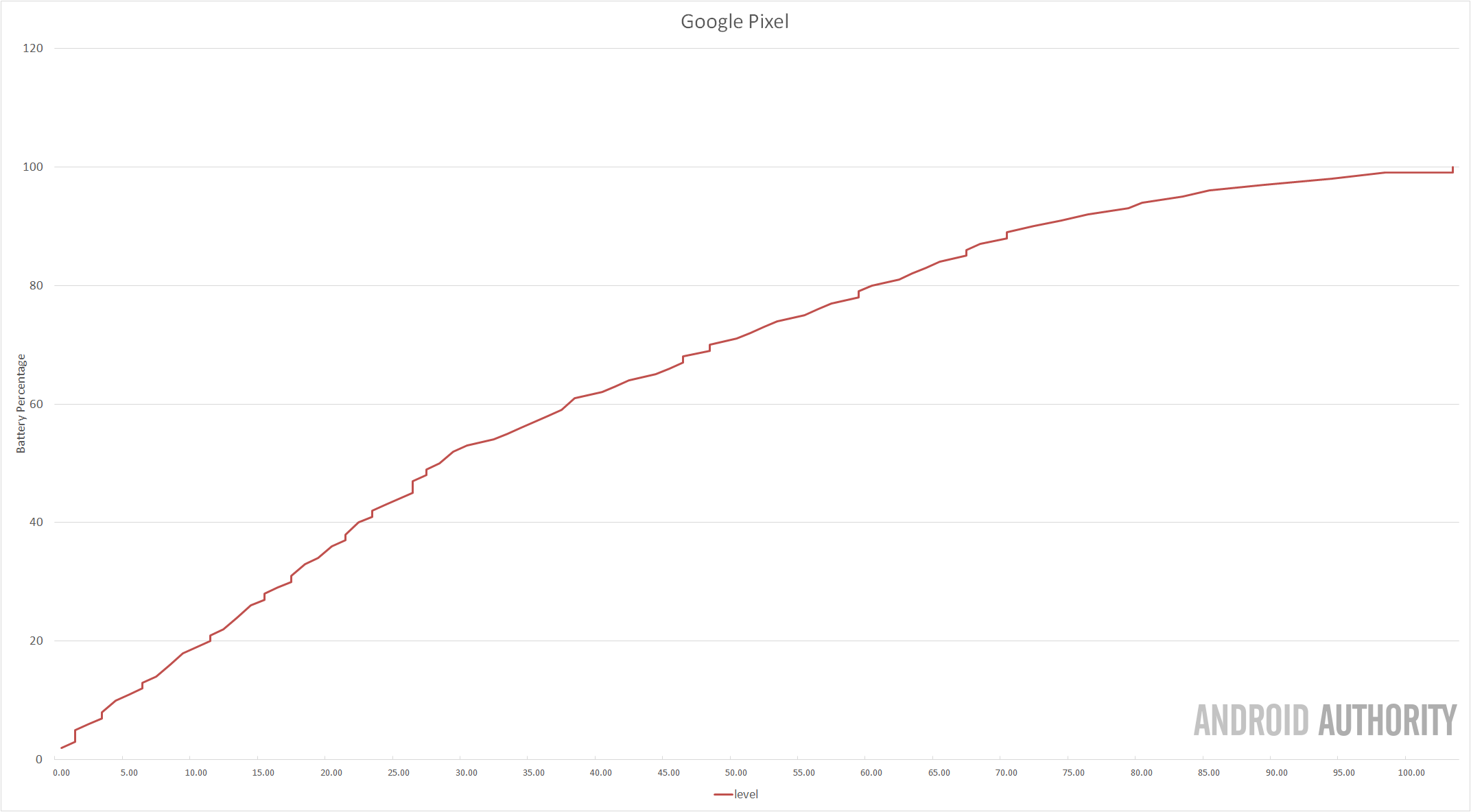
As for charging, you can charge the Pixel from < 5% to 100% in just over 1hr 40 mins, while to get to 50% takes less than half an hour and to get to 80% takes an hour. If you are in a mad rush then you can get 25% charge in just under 15 minutes! As with all quick charge system, the initial charging is much quicker than the final phase above 80%. For example the Pixel uses half of the charging time to go from 70% to 100%.
Camera
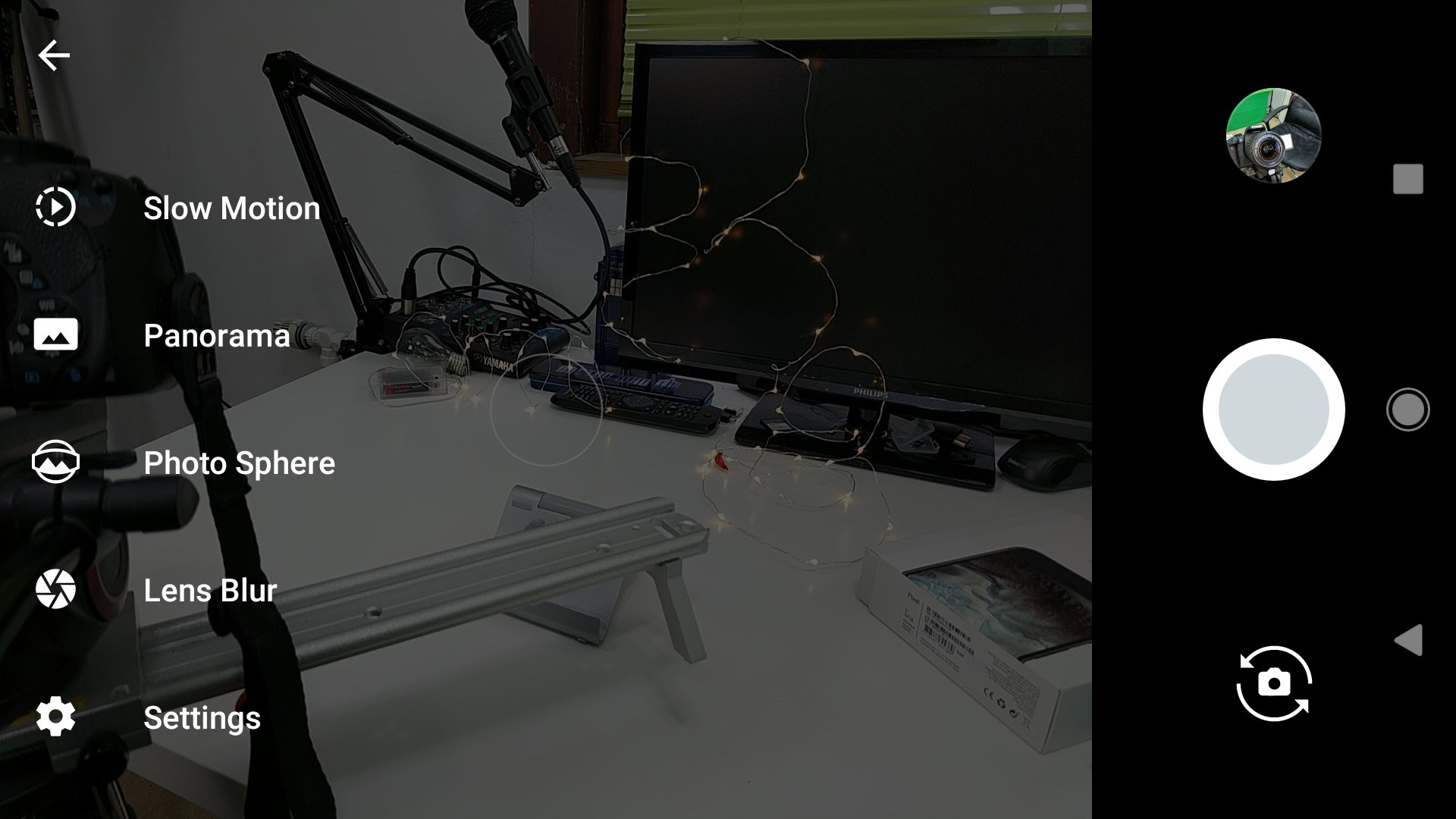
The specifications of the camera on the Pixel are excellent: 12.3MP rear camera with f/2.0 and 1.55μm large pixels. There is Phase Detection Autofocus (PDAF) as well as Laser Detection Autofocus (LDAF). It can record 4K @ 30fps and HD @ 240fps. On the front is an 8MP sensor with f/2.4 aperture and 1.4 µm pixels.
So I thought it would be interesting to see how the Pixel compares to a DSLR! So I took four pictures in controlled conditions (with a lightbox) to see how each one fared. My DSLR is a Canon EOS 700D. As you can see from the pictures below the 700D makes better pictures in good light. The colors are truer, there is more color depth and nuance. However for the close up of the Tardis door I would say that the Pixel did a much better job than the Canon. The text is clearer and there is less stippling. Also in low-light I would also say that the Pixel won. The EOS picture didn’t come out quite right because it is out of focus and maybe with more work I could have made it better.
Software
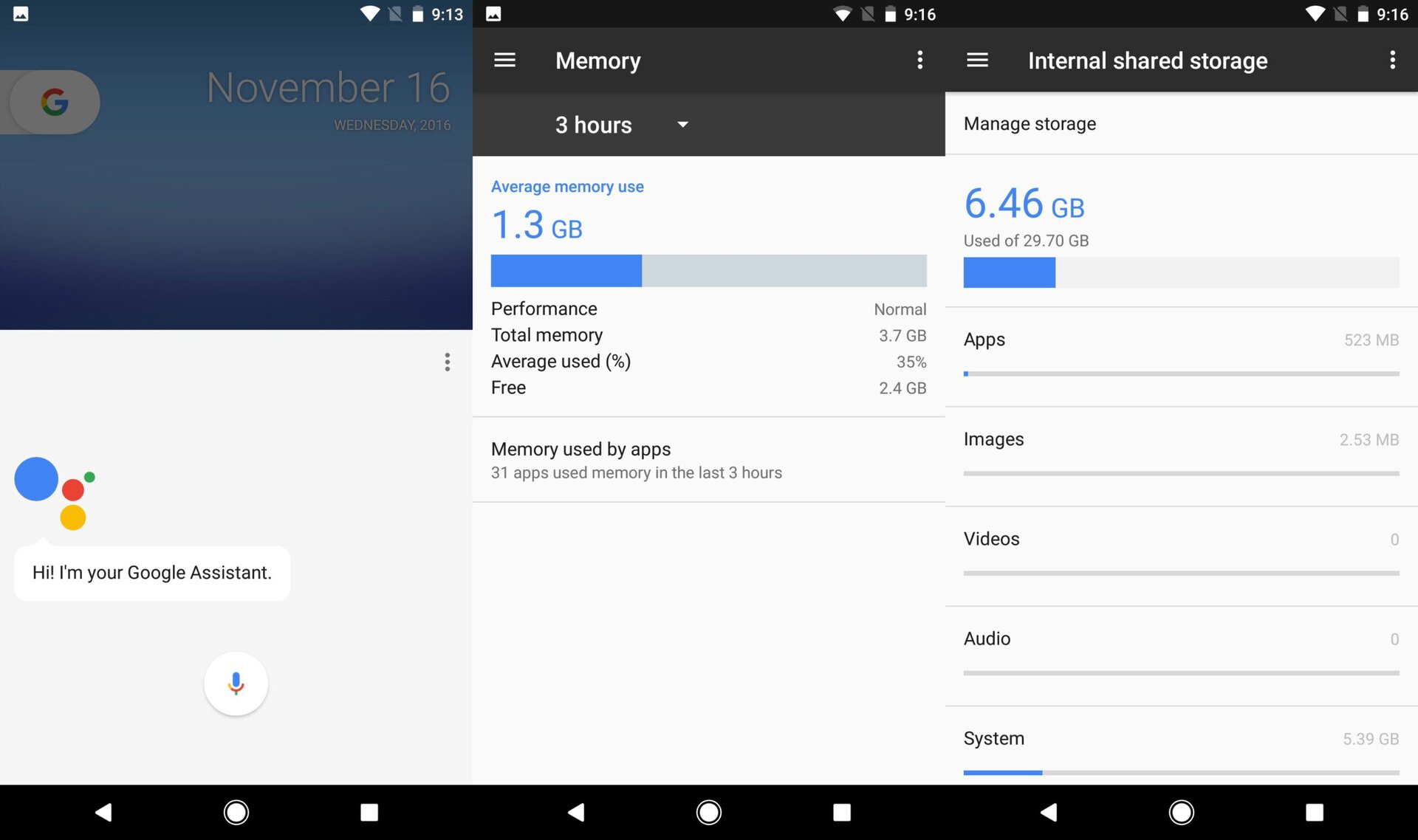
The Pixel and Pixel XL run Android 7.1 Nougat which brings with it a number of new features including Google’s new Pixel Launcher and the Google Assistant. The former is an incremental update to the standard Google Now Launcher which does away with the app drawer by making the installed apps available by swiping up from the bottom. The latter is Google’s new AI-based voice assistant, the same one in Google Allo, but now available throughout the whole Android interface.
In terms of storage and RAM, fresh out of the box the Pixel uses about 6.5GB of internal storage for Android and the default apps etc., which means there is around 23GB of free space. Both the Pixel and Pixel XL come with 4GB of RAM and from a fresh boot the phones uses around 1.3GB of RAM. During my testing (which was mainly running benchmarks, taking photos, playing videos etc.) I haven’t seen the average RAM usage go over 2GB.
Besides these two big ticket items there are lots of smaller changes including launcher shortcuts, a new storage manager called Smart Storage, GIF support in the Google Keyboard, and improved VR thread scheduling:
- App Shortcuts – These allow users to access key actions within an app directly from the launcher. You just long-press an app’s launcher icon to reveal the app’s shortcuts, then tap on a shortcut to jump to the associated action.
- GIF support in the Google Keyboard – Android 7.1 supports the new Commit Content API, which provides a universal way for keyboards to send images and other rich content directly to a text editor in an app.
- Smart Storage – If an app requires more space than is currently available, it can use the Smart Storage page to let the user delete unneeded apps and content to free up sufficient space.
- Improved VR thread scheduling – Android 7.1 provides new features to improve VR thread scheduling. Apps can now designate one thread as a VR thread. While the app is in VR mode, the system will schedule that thread more aggressively to minimize latency.
Wrap-up
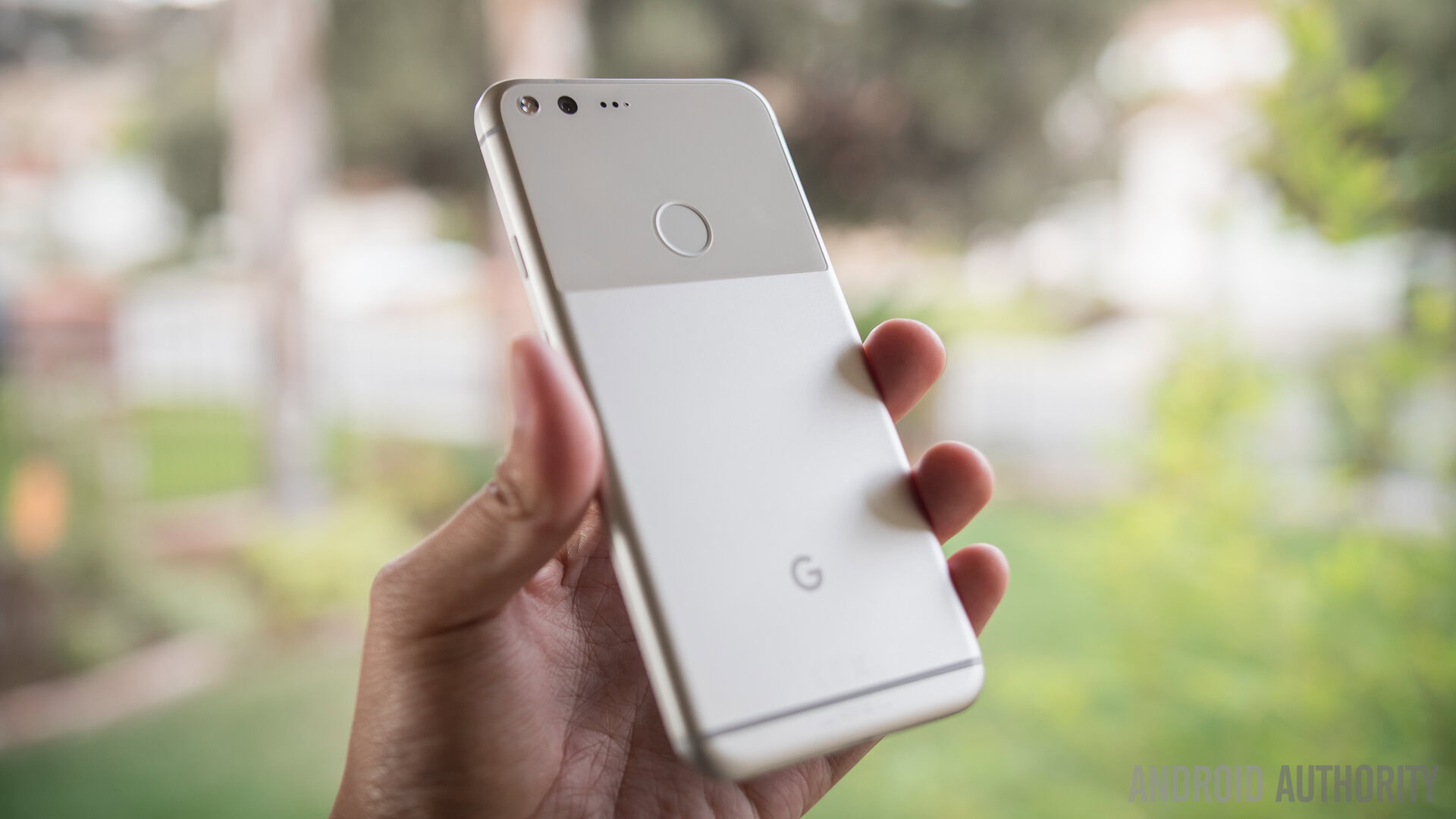
There are many non-technical factors to choosing your next Android smartphone including price, availability, branding and long term support. However if we push those to the side for the moment at just look at the tech, it is clear that the Pixel and Pixel XL are leading edge devices. Here we find AMOLED displays and not LCD, plus the XL sports QHD resolution.
The SoC is the best Qualcomm has to offer today and the benchmarks show that it is the best in its field (in the majority of cases). You also have excellent cellular support with the X12 modem. On top of that you have a good camera, an above average battery, an option for 128GB of internal storage and the latest version of Android.
What we don’t have is an SD card slot, wireless charging, optical image stabilization, front facing speakers or proper waterproofing (like IP67). So while everything that the Pixel does include is top of the range, it might be what it doesn’t include that could be the deciding factor for you! Let me know what you think in the comments below!